

The objective function is arranged such that the vector contains all of the (singly-differentiated) linear terms and contains all of the (twice-differentiated) quadratic terms. 3,4 The problem was first explored in the early 1950s, most notably by Princeton University's Wolfe and Frank, who developed its theoretical background, 1 and by Markowitz, who applied it to portfolio optimization, a subfield of finance.Ī general quadratic programming formulation contains a quadratic objective function and linear equality and inequality constraints: 2,5,6 QP is widely used in image and signal processing, to optimize financial portfolios, to perform the least-squares method of regression, to control scheduling in chemical plants, and in sequential quadratic programming, a technique for solving more complex non-linear programming problems. 1 The objective function can contain bilinear or up to second order polynomial terms, 2 and the constraints are linear and can be both equalities and inequalities.

Quadratic programming (QP) is the problem of optimizing a quadratic objective function and is one of the simplests form of non-linear programming.


 0 kommentar(er)
0 kommentar(er)
